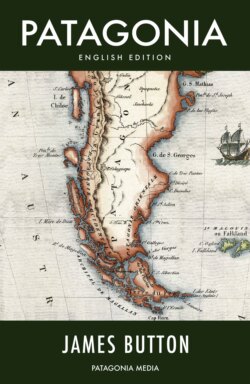Читать книгу Patagonia - James Button - Страница 8
На сайте Литреса книга снята с продажи.
Introduction
ОглавлениеThis history of Patagonia covers the era of its discovery in the 16th Century, up to the era of the majority of European explorations, in the 19th Century. It describes its geographical borders, its flora and fauna, as well as its indigenous population, their habits and customs, including a dictionary of distinct native languages. The book covers the history of mainland Patagonia from Carmen de Patagones to the Straits of Magellan (Tierra del Fuego) on the Atlantic side, and from Cape Horn to the Río Calle-Calle at Valdivia and the Patagonian Islands, on the Pacific side.
It also includes a chronology of the origins and motives that gave rise to Patagonia’s discovery when the Spanish Crown felt the need to find a new sea route for the Spice Trade. This effort was initiated by Christopher Columbus and followed by Amerigo Vespucci, to be completed by Ferdinand Magellan, who succeeded in finding the maritime passage that unites the Atlantic Ocean with the Pacific Ocean via southern Patagonia. This was the greatest achievement of the era and was followed by the explorations carried out by Ladrillero, Sarmiento de Gamboa and other explorers, who persevered in their attempts to occupy Tierra del Fuego and the territories of Magellan in the name of the Spanish Crown.
It is important to understand, however, that PATAGONIA is an imaginary region, whose actual geography consists of Argentine Eastern Patagonia and Chilean Western Patagonia. Yet it is a single territory, filling the southern cone of the American Continent, beginning at 39°49’ southern latitude, with a natural division between east and west formed by the Andes Mountains. I have therefore focused on Argentine and Chilean Patagonia, treating the subject as one single territory called PATAGONIA.
It is natural that there are general misconceptions regarding this matter, considering it covers a geographical area that corresponds neither to a political entity nor to an economic one. This also explains the limited interest among the South American population in the region’s history since Spanish Rule came to an end.
This underpopulated land, with its rugged geography of vast highland plains, volcanoes, valleys, islands and fjords, drew me to compare its extent with European countries. I discovered Patagonia is an area of over one million square kilometers, which equals the combined size of France, England and Germany. Its historical spirit is similar to the region occupied by Provence, the ancient province in the South of France.
The Patagonian region of Chile covers a narrow strip south of the city of Valdivia, framed by the Pacific Ocean to the west and the Patagonian Andes to the east via the Río Calle-Calle. On the Argentinean side, mountain terraces descend to the Atlantic Ocean via the Río Negro, reaching the mouth of the river at the point known as Carmen de Patagones. To the south, Patagonia extends to Tierra del Fuego and the Straits of Magellan and is known as Continental Patagonia. On the Atlantic Ocean side, the Falkland Islands are included to the south-east of Continental Patagonia, as are all the islands that surround Cape Horn, as well as the fjords and islands reaching north to Valdivia, including the island of Chiloé. This area is known as Insular Patagonia.
Thus, the newly discovered routes opened by navigators paved the way for getting to know this Terra Incognita and it was explored by pirates such as Sir Francis Drake and Sir Thomas Cavendish, followed by scientific explorers, such as Le Maire, Musters and Darwin, and also came under the influence of Jesuit missions in the 17th Century, by fathers Mascardi and Falkner.
The motives that inspired the Medici, Fuggers and Charles V to finance and sponsor exploratory expeditions for a new route to the Indies in the 16th Century are reviewed. The knowledge of the strategic sea channel in Patagonia made exploration rewarding, culminating in German settlement during the era of President Bulnes, which was initiated in Valdivia in 1845, at Osorno and Llanquihue, in Chile. Similarly, we look at Welsh settlement in Argentine Patagonia that was promoted by the teacher Michael Jones and realized in the province of Chubut, at the beginning of 1863, which consolidated the European presence in the region.
The Salesian missionaries sent from Italy to Tierra del Fuego by Don Bosco in the 19th Century helped pacify the indigenous population by means of their religious conversion. The Conquest of the Desert led by General Roca, on the other hand, allowed Argentina to annex an extensive area by more violent means. Attempts to create a French Kingdom in Araucania and Patagonia did not succeed. The development of sheep farming, of industry, and of commerce in the Straits of Magellan, as well as to the dream of discovering the ‘City of the Caesars,’ was the magnet that fuelled this story, from the early 16th Century. It triggered a mystical fever for gold that kept the spirit of adventure burning and endured throughout the southern cone of the American Continent over three centuries.
